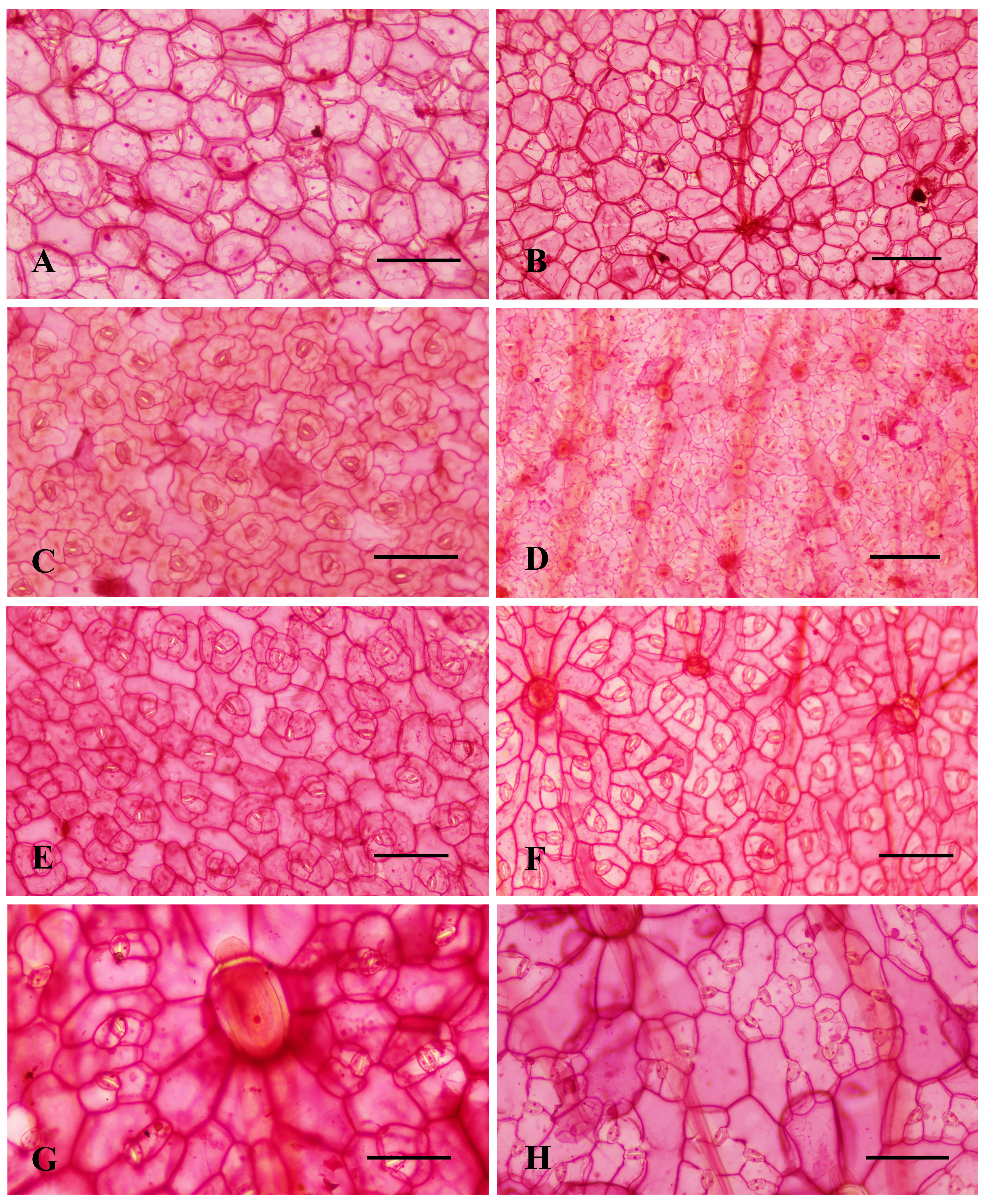Leaf Epidermal Anatomy of Some Crotalaria L. (Fabaceae) Species in Thailand
DOI:
https://doi.org/10.58837/tnh.24.1.258597Keywords:
Crotalarieae, Leguminosae, species pairs, taxonomyAbstract
The leaf epidermal anatomy of 23 Crotalaria species was studied. The leaf epidermis was prepared by peeling and clearing methods and observed by a light microscope. The results of the leaf epidermis showed that the shape of an epidermal cell is polygonal, irregular or jigsaw-like and the anticlinal wall is straight, curved or undulated. There are two stomatal types: anomocytic and anisocytic, while the trichome is uniseriate. The papillae are presented in C. acicularis. The leaf epidermal anatomical characteristics cannot be used for species identification, however the shape and anticlinal wall of the epidermal cell and the presence of trichomes can be used to determine species pairs.
References
Adema, F. 2006. Note on Malesian Fabaceae (Leguminosae-Papilionoideae) 12. The genus Crotalaria. Blumea 51(2): 309–332.
Al-Edany, T.Y. and Al-Saadi, A.A.A.M. 2012. Taxonomic significance of anatomical characters in some species of the family Myrtaceae. American Journal of Plant Sciences 3: 572–581.
Al-Joboury, K.R. 2016. Petiole anatomical study for some species of Astragalus L. sect. Proselius (Fabaceae family) in Iraq. Journal of Genetic and Environmental Resources Conservation 4(1): 57–59.
Barykina, R.P. and Kramina, T.E. 2006. A comparative morphological and anatomical study of the model legume Lotus japonicus and related species. Wulfenia 13: 33–56.
Chiarini, F. and Barboza, G. 2007. Anatomical study of different fruit types in Argentine species of Solanum subgen. Leptostemonum (Solanaceae). Anales del Jardín Botánico de Madrid 64(2): 165–175.
Clarke, P.A. 2008. Aboriginal plant collectors botanists and Australian Aboriginal people in the nineteenth century. Rosenberg Publishing, 197 pp.
Devecchi, M.F., Pirani, J.R. and de Pinna, G.F.A.M. 2014. Comparative leaf anatomy and morphology of some Brazilian species of Crotalaria L. (Leguminosae: Papilionoideae: Crotalarieae). Acta Botanica Brasilica 28(4): 583–593.
Horn, J.W., Fisher, J.B., Tomlinson, P.B., Lewis, C.E. and Laubengayer, K. 2009. Evolution of lamina anatomy in the palm family (Arecaceae). American Journal of Botany 96(8): 1462–1486.
Itharat, P. 2009. Handbook: technique in biology. Department of Biology, Faculty of Science, Khon Kaen University, Thailand. (in Thai)
Lackey, J. 1978. Leaflet anatomy of Phaseoleae (Leguminosae: Papilionoideae) and its relation to taxonomy. Botanical Gazette 139(4): 436–446.
Le Roux, M.M., Boatwright, J.S. and van Wyk, B.E. 2013. A global infrageneric classification system for the genus Crotalaria (Leguminosae) based on molecular and morphological evidence. Taxon 62(5): 957–971.
Lewis, G., Schrire, B., Mackinder, B. and Lock, M. 2005. Legumes of the World. Royal Botanic Gardens, Kew, 577 pp.
Mabberley, D.J. 2008. Mabberley’s plant-book: a portable dictionary of plants, their classification and uses. 3rd ed. Cambridge University Press, 1040 pp.
Mabel, A.F., Johnson, A.A. and Temitope, O.O. 2013. Petiole anatomy of some species of Asteraceae in southwest Nigeria. African Journal of Plant Science 7(12): 608–612.
Mbagwu, F.N. and Edeoga, H.O. 2006. Leaf anatomy of some Nigerian species of Vigna Savi (Leguminosae-Papilionoideae). Agricultural Journal 1(1): 5–7.
Ninkaew, S. and Chantaranothai, P. 2015. The genus Butea Roxb. ex Willd. (Leguminosae-Papilionoideae) in Thailand. Chiang Mai Journal of Science 42(2): 367–375.
Ninkaew, S., Balslev, H., Pornpongrungrueng, P. and Chantaranothai, P. 2017. Crotalaria L. (Fabaceae: Faboideae) in continental Southeast Asia. Phytotaxa 320(1): 1–74.
Niyomdham, C. 1978. A revision of the genus Crotalaria L. (Papilionaceae) in Thailand. Thai Forest Bulletin (Botany) 11: 105–181.
Parveen, S.N., Murthy, K.S.R. and Pullaiah, T. 2000. Leaf epidermal characters in Crotalaria species (Papilionoideae) from Eastern Ghats. Phytomorphology 50(2): 205–212.
Prasawang, S. and Srinual, A. 2020. Comparative leaf and wood anatomical characteristics of Chrysophyllum (Sapotaceae) relate to taxonomy of the species in Thailand. Biodiversitas 21(4): 1578–1587.
Saheed, S.A. and Illoh, H.C. 2010. A taxonomic study of some species in Cassiinae (Leguminosae) using leaf epidermal characters. Notulae Botanicae Horti Agrobotanici Cluj-Napoca 38(1): 21–27.
Saisorn, W. and Chantaranothai, P. 2015. Taxonomic studies on the genus Phyllodium Desv. (Leguminosae) in Thailand. Tropical Natural History 15(1): 23–40.
Subramaniam, S. and Pandey, A.K. 2013. Taxonomy and phylogeny of the genus Crotalaria (Fabaceae): an overview. Acta Biologica Indica 2(1): 253–264.
Sutjaritjai, N., Wangpakapattanawong, P., Balslev, H. and Inta, A. 2019. Traditional uses of Leguminosae among the Karen in Thailand. Plants 8(600): 1–20.
Suwanchaikasem, P., Phadungcharoen, T. and Sukrong, S. 2013. Authentication of the Thai medicinal plants sharing the same common name ‘Rang Chuet’: Thunbergia laurifolia, Crotalaria spectabilis, and Curcuma aff. amada by combined techniques of TLC, PCR-RFLP fingerprints, and antioxidant activities. ScienceAsia 39(2): 124–133.

Downloads
Published
How to Cite
Issue
Section
Categories
License
Chulalongkorn University. All rights reserved. No part of this publication may be reproduced, translated, stored in a retrieval system, or transmitted in any form or by any means, electronic, mechanical, photocopying, recording or otherwise, without prior written permission of the publisher











